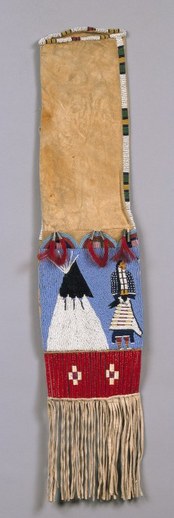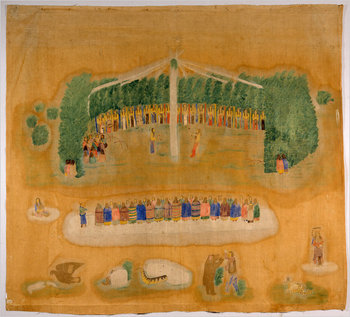So, as I said, in reporting my New York Times article about attributing Native American art to individuals, especially at the Denver Art Museum’s newly reinstalled galleries, I learned many interesting/valuable things that I could not squeeze into the article.
 Hence this post. The attribution research movement, if I may call it that, fascinates me. It began decades ago, and by now should have had a far bigger impact on museums.Â
Hence this post. The attribution research movement, if I may call it that, fascinates me. It began decades ago, and by now should have had a far bigger impact on museums.Â
True, the vast majority of Native American works will never be attributed, but that is no excuse, as Dan Monroe, director of the Peabody Essex Museum (which has a large Native American collection), says in the article. When researchers can identify a masterly “hand,” they can use the “master of” moniker — as the pipe bag at left is attributed to the Master of the Cheyenne River Sioux.
Strangely, some Native American art experts I consulted had no knowledge of the attribution research. (It makes me wonder what else is going on in academia that should be brought to the attention of the general museum-going public. Suggestions?)
I wish I could have mentioned others doing this valuable, but complex work, so let’s start with a shout-out to some other I learned about:
- Kate C. Duncan (who is quoted in the article, but whose research work had to be cut) has grouped – but not found artist’s names for Athapaskan floral beadwork and is working on early 19th quilled tunics of the Dena’ina.
- Ruth B. Phillips, of CarletonUniversity, has studied the art by Great Lakes indigenous peoples.
- Joyce M. Szabo, of the University of New Mexico; Janet Catherine Berlo, of the University of Rochester; Candace Greene, of the Smithsonian, and Barbara A. Hail, curator emerita at the Haffenreffer Museum of Anthropology of Brown University, have all analyzed art of the Plains Indians.
-
David W. Penney, of the Detroit Institute of Arts, was a consultant to the National Museum of the American Indian and made the two new attributions quoted in my article, according to curator Ann McMullen.
-
Peter Corey, curator of collections at the ShermanJacksonMuseum in Sitka, worked
 with Kathryn Bunn-Marcuse, whom I mention, to discover the names of Tlingit artists in 19th C documents. They plan to publish their database (soon) to help speed their attribution work.
with Kathryn Bunn-Marcuse, whom I mention, to discover the names of Tlingit artists in 19th C documents. They plan to publish their database (soon) to help speed their attribution work. -
Steven C. Brown, a former curator at the Seattle Art Museum, worked on Northwest Coast art.
I know there are others doing this work — add your name, or their names, with a comment below, please.
It may help speed the use of the research. As Robin Wright, director of the Bill Holm Center at the Burke Museum, told me, “some museums just haven’t read the current literature.” And as Nancy Blomberg, the curator in Denver responsible for the reinstallation, admitted, she hasn’t yet told a couple of other museums that own work by Louis Fenno (his painting of the Ute Bear and Sun Dances is above right) that she has rediscovered him. (A commenter to the NYT article posted this link to pictures of Fenno and his wife, Ar-ruv-a-roo.)
Â
Another strain of my reporting dealt with what to do when the artist’s name is unknown to signal the individual. “Anonymous” is appropriate, as is “Unknown Artist.” Curator Karen Kramer Russell at the Peabody Essex is using “Tlingit Artist” or “Osage Artist,” etc. instead of just “Tlingit” and “Osage.”Â
Â
Museums can also group the display of objects thought to be made by a single hand, as Denver is doing. And anonymous Native American works can also be linked to works by the same hand in other collections. Russell told me, for example, that PEM owns an 1840s Dakota cradleboard that seems to be made by the same individual who made cradleboards at the Brooklyn Museum (which will soon open a Plains Indian tipi exhibition) and the Smithsonian Natural History Museum. The Peabody Essex also owns a Haida mask, one of 14 known masks that scholars of Northwest Indian art attribute to one artist who remains anonymous — for now. If those links aren’t made on labels, they could at least be linked in the catalogues, so that scholars will know of the connections.Â
Â
I can almost hear some grumbling at museums — they have enough to do with fewer resources at the moment to start changing labels, let alone do their own attribution research. True, but Monroe also blames inertia: “In most instances, museums continue the practice of labeling historical Native American in relation only to tribe simply because it has long been ‘standard’ practice. Few museums have given thought to the meaning and significance of this practice though none would consider labeling Western art in the same manner,” he told me.
Â
That’s enough for now. I’ll publish a few more thoughts soon.Â
Â
Photo Credits: Courtesy of the Denver Art Museum
